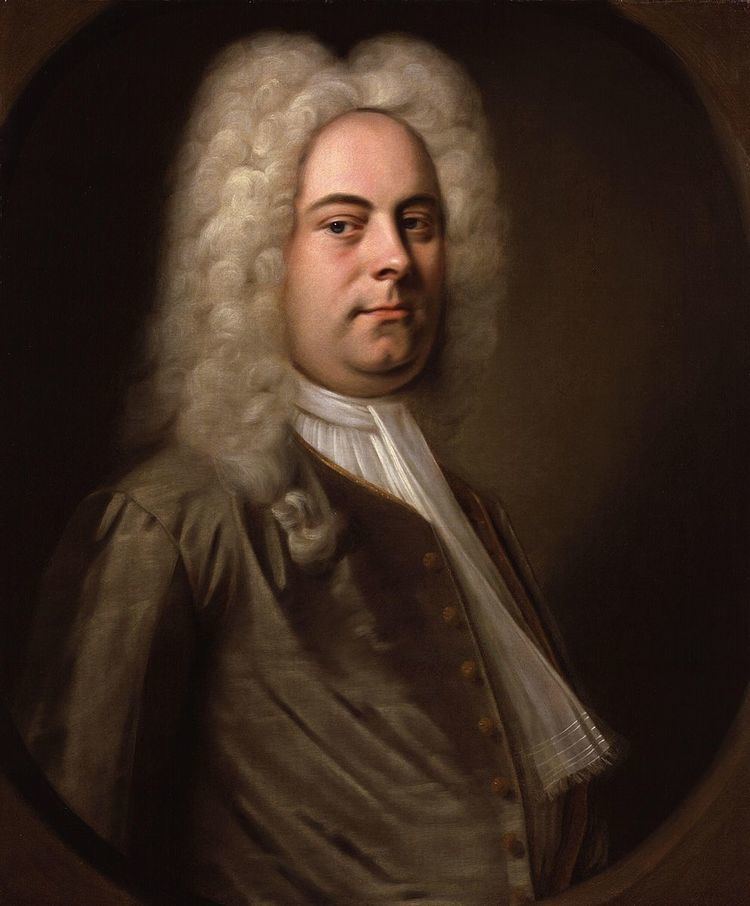 | ||
Judas Maccabaeus (HWV 63) is an oratorio in three acts composed in 1746 by George Frideric Handel based on a libretto written by Thomas Morell. The oratorio was devised as a compliment to the victorious Prince William Augustus, Duke of Cumberland upon his return from the Battle of Culloden (16 April 1746). Other catalogues of Handel's music have referred to the work as HG xxii; and HHA 1/24.
Contents
Synopsis
Morell's libretto is based on the deuterocanonical or apocryphal book 1 Maccabees (2–8), with motives added from the Antiquitates Judaicae by Flavius Josephus.
The events depicted in the oratorio are from the period 170–160 BC when Judea was ruled by the Seleucid Empire which undertook to destroy the Jewish religion. Being ordered to worship Zeus, many Jews obeyed under the threat of persecution; however, some did not. One who defied was the elderly priest Mattathias who killed a fellow Jew who was about to offer a pagan sacrifice. After tearing down a pagan altar, Mattathias retreated to the hills and gathered others who were willing to fight for their faith.
Handel's music depicts the changing moods of the Jewish people as their fortunes vary from dejection to jubilation.
Part 1
The people mourn the death of their leader Mattathias, but his son Simon tries to restore their faith and calls them to arms (Arm, arm, ye brave). Simon's brother, Judas Maccabaeus, assumes the role of leader and inspires the people with thoughts of liberty and victory through the power of Jehovah.
Part 2
The people have been victorious, but Judas is concerned that vanity will cause the people to claim victory for themselves. When news arrives that the Seleucid commander Gorgias is preparing to enact revenge, the people's joyous mood gives way to wailing and dejection (Ah! wretched Israel!). Again Judas rallies the people (Sound an alarm) and insists that the pagan altars must be destroyed and that false religions must be resisted.
Part 3
Victory has finally been achieved for the Jewish people (See, the Conqu’ring Hero Comes!). News arrives that Rome is willing to form an alliance with Judas against the Seleucid empire. The people rejoice that peace has at last come to their country (O lovely peace).
First performance
The first performance took place on 1 April 1747 at Covent Garden, and Judas Maccabaeus became one of Handel's most popular oratorios. The General Advertiser (issued on the day prior to the concert) announced the event as:
The performers in this original 1747 production included:
The famous chorus See, the Conqu’ring Hero Comes! was composed during the summer of 1747 for Handel's next oratorio, Joshua. In the wake of its popularity, probably in 1751, Handel added it to Judas Maccabaeus, and so it forms a legitimate part of both oratorios.
Popular uses
The Halifax Choral Society owns a manuscript which purports to be a re-orchestration of the oratorio by Mozart.
Ludwig van Beethoven composed twelve variations on See, the Conqu’ring Hero Comes! for piano and cello in 1796 (WoO 45). In 1884 the Swiss writer Edmond Louis Budry wrote new French words to the same chorus, creating the Easter hymn " À toi la gloire, O Ressuscité!", which was later translated into English as "Thine Be the Glory". See, the Conqu’ring Hero Comes! also gained familiarity as the tune invariably played by brass bands at the opening of new railway lines and stations in Britain during the 19th century, and it was adopted as a movement in Sir Henry Wood's Fantasia on British Sea Songs, played at the BBC Proms.
Come, ever smiling Liberty, / And with thee bring thy jocund train is sung by Maria, the heroine of Mary Wollstonecraft's novel Maria (1798), at the point where she believes herself to have escaped from her abusive husband. She calls her state "Comparative liberty", suggesting that "the jocund train lagged far behind!" because she takes no pleasure in her need for the separation.
Judas Maccabaeus was translated into German and published in 1866 as Volume 22 of the Händel-Gesellschaft. A Hebrew translation by Aharon Ashman, prepared for the 1932 Maccabiah Games, has become popular in Israel during Hanukkah. Another Hebrew version for Hanukkah (not a translation) was written by the Israeli children's poet and author Levin Kipnis.
To this day, an instrumental rendition of the chorus is played during award ceremonies at Japanese schools while recipients proceed to the stage to receive their awards.
Orchestration
The following orchestration was recorded by Chrysander in the Händel-Gesellschaft edition of 1866:
Dramatis Personae
Summary
The following table summarises the movements of the oratorio.
